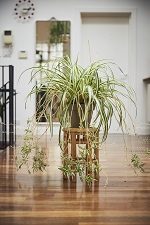By Sabita Saldanha
As a plant enthusiast I enjoy collecting both indoor and outdoor plants. Plants that are easy to maintain and grow well with minimal light are top on my list of houseplants to must have. For those who are plant newbies and believe you do not have a green thumb you cannot go wrong with the care of a peace lily, dracaena, spider plant, aloe, Boston fern, rubber plant, pothos, dieffenbachia and anthuriums. These plants have vibrant and dense foliage which can brighten any space, are easy to grow and propagate, and wonderful gifts for any occasion. I am a proud owner of all these plants, and some of them I have had for years. Most often peace lilies and anthuriums are given as tokens in memoriam or at special occasions. I received a peace lily when my mother-in-law passed away and I have had her for eight years! The anthurium I have was a gift by my husband for our anniversary and she is beautiful! She outgrew her container and I had to repot her. I got three new anthurium plants from one. Additionally, like birth stones, the birth plant of my birth month is an anthurium, so she is extra special. As I care for them and watch them grow, they bring me immense joy and happiness!
Akin to the plethora of benefits that outdoor plants and trees provide to the environment and ecosystem, houseplants impart similar effects to the indoor environment. Nothing like a daily supply of fresh oxygen, and from an aesthetic point of view, a sense of mental calm and peace. However, what one may not be aware of is that a certain group of house plants and classified as “air purifiers”. Included under this category are peace lilies, dracaena, spider plant, aloe, rubber plant, pothos, dieffenbachia (dumbcane) and anthuriums. Using biospecimens like plants as air filters serves two purposes, provides ornamental décor while cleaning indoor air.
Indoor air is often tainted with volatile organic compounds. Volatile organic compounds (VOC’s) come from sources from within the home or office. Enclosed spaces with confined ventilation systems contribute to VOCs in indoor air. They stem from materials used in the construction of the home, individual habits, and activities, etc. Formaldehyde, benzene, trichloroethylene, and toluene (paint thinners, glues, cigarette smoke) are classified as VOCs and are found in indoor environments and may contribute to health issues. The use of plants that remove harmful chemicals either through direct absorption or through changes brought about by microbes in the soil in which the plant grows is termed phytoremediation.
NASA conducted a scientific study on a few houseplants to determine their potential as air purifiers and their effectiveness at removing VOC’s. The study included several indoor ornamental plants, including peace lilies dracaena, spider plant, aloe, rubber plant, pothos, dieffenbachia (dumbcane) and anthuriums. The aloe plant has exceptional medicinal value as well.
The scale of efficient removal is affected by the type of plant and concentration level of VOCs. The NASA study was done in 1989 and in controlled chamber environments. With newer tools and technologies in place further studies are needed and should be extended to houseplants that are not tested yet.
In summary, the use of ornamental potted plants presents a biosafe approach to detoxify indoor air in homes and offices spaces. The number and the type of plants needed per square foot will also need to be empirically determined. Nonetheless, houseplants do play a role in purifying air so every time you breath you can enjoy a breath of fresh air!
Sabita Saldanha, an intern in the 2020 Master Gardener Class, lives in Montgomery. For more information on becoming a master gardener, visit www.capcitymga.org or email capcitymga@gmail.com
 Part of the Alabama Cooperative Extension Service (ACES)
Part of the Alabama Cooperative Extension Service (ACES)
